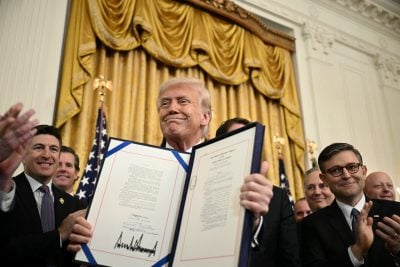The use of stablecoins – a type of cryptocurrency that is supposed to be backed by the US dollar or another reference asset – is likely to be given a further boost in Africa, with President Donald Trump making moves to promote uptake and Africans increasingly adopting stablecoins for cross-border payments and other transactions.
Stablecoins are a specific form of cryptocurrency which, in contrast to the high degrees of volatility seen in the prices of Bitcoin and other cryptos, aim to maintain stable values and thereby offer users the ability to make cross-border payments in a cheap and quick way.
To maintain this stability, they are backed by currency reserves, normally the US dollar. The two largest stablecoins currently available on the crypto market are Tether (USDT) and USD Coin (USDC), both of which claim to be backed 1:1 to US dollars or US Treasury securities.
Some consider stablecoins to be controversial because, despite their purported aim, there have been several high-profile collapses. In May 2022 the price of algorithmic stablecoin TerraUSD (UST) crumbled after it broke its peg with the US dollar, wiping out an estimated $45bn in market value within a week.
There has also been confusion about whether some stablecoins are fully backed by US dollars as they claim. In 2021, Tether paid $41m to settle a case brought by the US Commodity Futures Trading Commission (CFTC) over allegations that it had lied about its dollar reserves.
Coin usage increases as currencies devalue
Nonetheless, stablecoins are growing in popularity in Africa, where many countries face economic problems including high levels of inflation, rapid currency depreciation, and a shortage of foreign currency reserves – factors which have long driven cryptocurrency adoption in Africa. Advocates say the dollar-backed security of genuine stablecoins can be useful for both businesses and individuals wishing to facilitate international payments or simply protect the value of their assets.
A 2024 report from Chainalysis, a blockchain consultancy firm, established a firm correlation between currency devaluations in Africa and increased stablecoin use. For example, in Nigeria – which now ranks second in global crypto adoption indices – there was a marked increase in relatively small stablecoin transactions of under $1m after President Bola Tinubu devalued the naira in June 2023.
This suggests that consumers and small businesses increasingly turned to stablecoins as a proxy for the US dollar – hoping that it would retain its value amid high inflation in Nigeria and a weakening domestic currency.
Similar trends have been seen in Ethiopia. In July last year, the birr was freely floated for the first time as part of a liberalisation programme aimed at securing $10.7bn in loans and financial assistance from the International Monetary Fund (IMF) and World Bank. In the weeks immediately after, the currency lost as much as 30% in value, while stablecoin use increased. According to Chainalysis, Ethiopia is now Africa’s “fastest-growing market for retail-sized stablecoin transfers, with 180% growth year-over-year.”
Rob Downes, head of digital assets in Absa’s corporate and investment banking division in Johannesburg, tells African Business that “there’s no denying the growth and impact for anyone using stablecoins.”
“What started as individuals investing in crypto for expansion and asset growth has evolved into the increasing use of stablecoins for not only diversification purposes, but also to facilitate faster and cheaper cross-border and domestic payments,” he says.
“There are many businesses enabling these services, often for a fraction of the cost of traditional banking solutions and this trend is only going to continue growing as traditional and non-traditional service providers become more integrated.”
However, it is not just small retail investors who are turning to stablecoins. Downes says “there is certainly interest from our institutional clients to use stablecoins to manage sovereign currency volatility and inflation in some of our African markets, but there is also interest in using stablecoins for making and receiving payments.”
“However, there is still some uncertainty from clients – notably in South Africa – on making sure that they do not expose themselves to any regulatory risks with cross-border payments.”
Trump’s backing
With the recent return of President Trump, who has become an advocate for crypto after previously expressing scepticism, it appears the stage is potentially set for further growth in the stablecoin industry both in the US and around the world. Indeed, during his first week in office, Trump signed an executive order aimed at “promoting the development and growth of lawful and legitimate dollar-backed stablecoins worldwide.”
Trump’s ambition to further the growth of stablecoins appears to stem from his desire to protect the US dollar’s status as the world’s reserve currency. At a time when many emerging markets around the world are making steps towards “dedollarisation” – including several in Africa – Trump has pledged to uphold the supremacy of the dollar, including through punitive sanctions.
However, such measures would in theory be unnecessary should the pre-eminence of the dollar be maintained through the increased use of stablecoins worldwide. This is an argument that has been explicitly made by Tether’s CEO, Paolo Ardoino, who said last year that “stablecoins backed by dollars provide demand for US public debt.”
The White House’s new “crypto czar” David Sacks has also said that stablecoins offer “the opportunity to extend the dollar’s dominance internationally” and that the US could “basically create a digital dollar that people all over the world will use.”
Some are unconvinced that stablecoins could help achieve that aim. Philip Pilkington, an investment professional in London, tells African Business that “there is no logical connection between digital currency and reserve currency – literally none.”
“It sounds like a talking point from coin enthusiasts trying to shift product.”
That said, should the world’s largest economy move to promote the use of stablecoins and other digital assets, many believe that could promote its growth in Africa too. Chris Maurice, CEO of the pan-Africa crypto platform Yellowcard, recently argued at the World Economic Forum (WEF) in Davos that Trump’s embrace of the industry has changed “the entire narrative of the industry.”
Calls for regulatory certainty
He believes that African regulators will now need to move faster to establish a regulatory framework for the stablecoin and wider digital assets industry, in order to keep up with developments in the US and worldwide, and that will in turn fuel more rapid growth.
Downes similarly believes that “a more favourable environment for digital assets and stablecoins in North America will encourage faster action in Africa, from both regulators and private businesses.”
“Regulation is essential to ensure robust and fair financial markets, and this needs to be accelerated across Africa. We know that regulators are working together globally to share best practice and evaluate what will work best for each continent and each country,” Downes says.
“While many of the markets Absa operates in have established some form of regulation and licencing, which are very positive steps in the right direction, there are still areas of regulation that need to be made clearer and fast-tracked to stimulate participation by banks. Once banks are more actively participating, it will spur the next wave of adoption.”
Want to continue reading? Subscribe today.
You've read all your free articles for this month! Subscribe now to enjoy full access to our content.
Digital Monthly
£8.00 / month
Receive full unlimited access to our articles, opinions, podcasts and more.
Digital Yearly
£70.00 / year
Our best value offer - save £26 and gain access to all of our digital content for an entire year!

 Sign in with Google
Sign in with Google 



